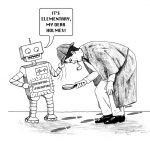This page provides references and capsule descriptions of my articles on planetary science and astronomy.
See also the Books page for The Big Splat, or How Our Moon Came to Be, published by John Wiley & Sons in 2003.
Liquid Asset. New Scientist, 3 April 2010, p. 39.
LCROSS crash-landed on the moon in October 2009 and ushered in a new era of lunar science, by proving that there are substantial deposits of water at the lunar poles. It could be a game-changer for lunar exploration, but political realities make that seem less and less likely.
Why the moon still matters. New Scientist, 11 July 2009, p. 30.
On the fortieth anniversary of Neil Armstrong’s first steps on the moon, I review the myths Apollo laid to rest, the great discoveries that came out of the Apollo missions (#1: a whole new view of the early solar system in which collisions are the dominant process), and the questions that remain unanswered.
The moonbots have landed. New Scientist, 12 July 2008, p. 34.
A preview of upcoming unmanned missions to the moon, featuring GRAIL (a gravitational field mapper) and the International Lunar Network (which would study lunar seismology and the moon’s patchwork magnetic field).
Don’t blame it on the gods. New Scientist, 14 June 2008, p. 50.
The lunar eclipse of 478 BC led a young Greek philosopher named Anaxagoras to the correct explanation of eclipses, and it arguably marks the beginning of experimental science.
The Gritty Problem of Moon Dust, New Scientist, 28 May 2005.
When the Apollo astronauts walked on the moon, they could not have ventured out for a fourth moon walk because their space suits were so fouled up by moon dust. If we ever want to go back for longer stays, scientists will have to figure out how to control the stuff. That means they need some fake moon dust to experiment with, because there isn’t enough real moon dust to go around. But how do you make fake moon dust? Easier said than done!
The Loneliest Lab, New Scientist, 31 January 2004, 32-33.
In January, George W. Bush proposed a multi-year plan to send astronauts to the moon and Mars. Mars gets most of the publicity, but there is lots of good science that could be done at a moon base: exploring the South Pole-Aitken basin, looking for ice deposits at the poles, and building a telescope under perpetually dark skies.
Here Comes the Sun, Discover, May 2004, 62-69.
Our seemingly mild-mannered Sun can kick up a fuss sometimes, as it did in 2003 when a spectacular solar storm released two of the most powerful X-ray flares on record. The effects on Earth were minor — this time — but out in space there was a long roster of damaged or dead satellites. This article explains how solar researchers are working to understand and predict the Sun’s behavior.
Is There Life Under the Ice?, Astronomy, August 2001, 32.
If you really want to go looking for water — and life — in the solar system, there’s no better place than Jupiter’s “Goldilocks” moon, Europa. It appears to have a global ocean underneath the ice, containing twice as much water as all of Earth’s oceans. This article discusses the debate over whether the ocean is buried under tens of kilometers of ice or close to the surface, and how we might explore it in the latter case.
Anselm’s Question, Swarthmore College Bulletin, June 2003, 16-21.
Astronomer Sandra Faber, named by Discover in 2002 as one of the 50 most influential women in science, had made a career of the biggest possible science. She helped discover the Great Attractor (the largest known structure in the universe); she was one of the two people who figured out the flaw in the mirror of the Hubble Telescope; and she found some of the earliest evidence for dark matter.






